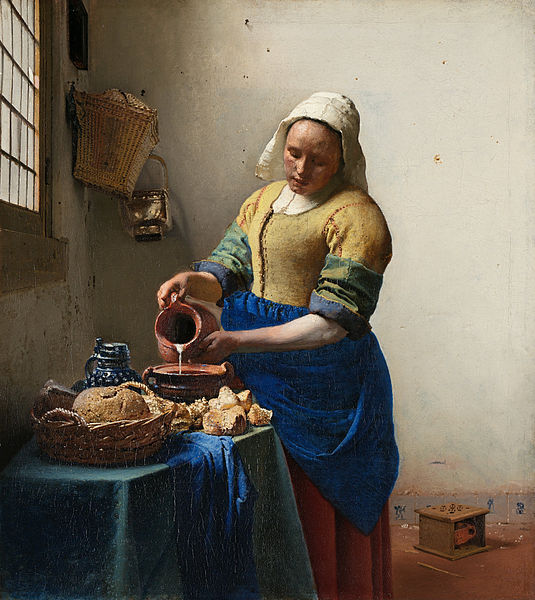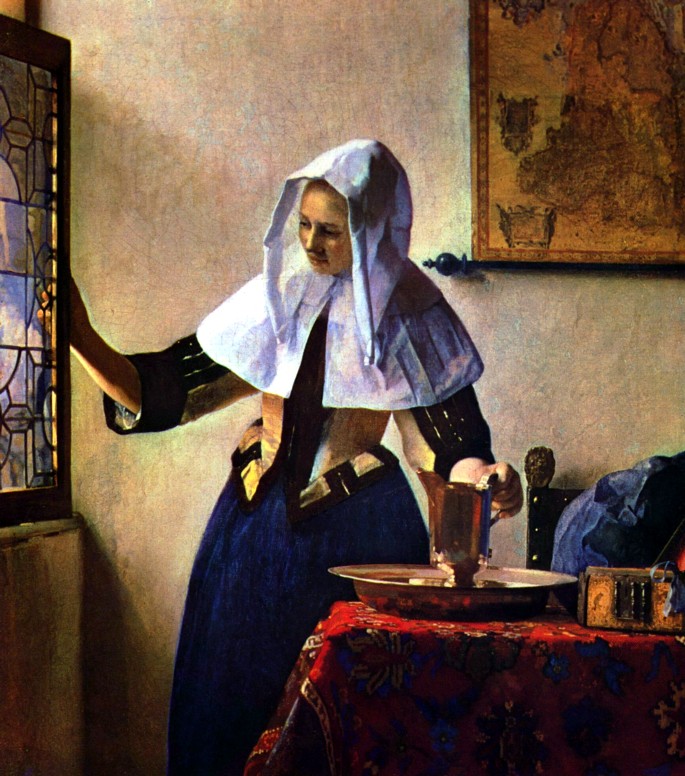Johannes Vermeer was born in Delft in the Netherlands, we know very little about his life, he lived in a small house with his wife and children. Delft had been in the forefront of a struggle to gain freedom from Spanish oppression until 1648, William of Orange, one of the leaders against the Spanish had died there earlier in 1584. The Eighty Year War had raged between 1568 to 1648, the Golden Age of paintings followed from the mid to late 17th.century, the Dutch led European trade, art and science. When the town became settled a small group of burghers administered in the town, dressed in the traditional black clothes of the Puritans. Delft was a centre for the earthenware industry, its narrow streets were built in a ‘classical regularity,’ winding canals reflected the houses and trees along its banks, Gothic churches were numerous, good subject matter for artists to portray. Many households owned small paintings showing elegant drawing rooms, domestic scenes and landscapes, large works of art were in the municipal buildings.
The art was not Baroque in the sense of love of splendour, more like the detailed realism found in early Netherland painting. Dutch Calvanism forbade the creation of religious art so scenes of every day life flourished, the painters looked to at the way light was used to great effect in the old masters, Vermeer was particularly skilled at creating light.
I have chosen two paintings to discuss, both using oil on canvas, the first, ‘A Maid -servant Pouring out Milk’ is now in the Rijks-museum in Amsterdam, the second ‘ Young Woman with a Water Jug, ‘ scenes of ‘upstairs downstairs,’ if you watched the television series years ago you will know what I mean. In the first painting Vermeer composes the images as a pyramid, the maid’s head at the top, he uses a dotted technique to paint the moving light on the crumbly bread and on her blue apron, the blue is ultramarine, which is expensive crushed lapis lazuli. The white of the coif against the white-washed wall is ‘a miracle of craftmanship’ colour against colour, tone against tone, the paint was lead white, we see the starched white cap against the cream and umber dress, covered by a glaze in the same colours.
Maids in Dutch art were seen in two ways, firstly one who may threaten the honour and security of the home and disturb the peace with her loose ways, or as Vermeer chose do in a bengin way, he treats his subject empathetically, he sees her as a person who symbolises a virtuous, hard working young woman, – we may ask ourselves, is she wistful or is she concentrating on her task. The young woman is sturdily built, solid, the weight of the table also also gives the impression of weight. It is thought that the maid is making a bread pudding, she slowly pours the milk into the dish called a Dutch oven, peices of bread, probably stale, are ready to be covered by the milk, ordinary food items, a typical domestic scene. Other symbols are also present which can have double meanings, one of the Delft tiles on the floor against the wall shows Cupid, an amorous symbol, the coals in the foot warmer behind the maid could be the hot coals of lust or the passion of a woman for her husband, even milk itself can be construed to contain sexual content!
Vermeer was a respected painter and art dealer, he was a member of the Guild House of St.Luke in Delft, guilds were later to become academies. In his early work, he portrayed every day items, simple motifs and characters such as in this painting, a maid working in the house, in the second painting the scene is one with probably the mistress of the house, painted between 1660 and 1662, by this tme Vermeer’s work had become more contemplative, he worked in a disciplined way. In the second painting the woman holds the gilded jug which is on a platter, the table is covered with a red -coloured table cloth on which is a jewellery box, a symbol of wealth, the scene is set in a private room, there is water and a basin, symbols of purity. The woman may be Vermeer’s wife or daughter, she is dressed in blue with a black and white over piece, on her head is a white cloth, she gazes out of the window, the light pours in, we see it on her arm particularly well, on the wall we see a map, two women with differing roles.
The artist David Hockney set a cat among the pidgeons when he thought he had proved that Vermeer had used camera obscura to aid his work in many paintings, others had thought so before him, it may be true, the evidence I saw in a documentary seemed convincing, but it does not belittle Vermeer’s genius. His work has a still quality which I like.
There is also a film called The Girl with the Pearl Earing which is an imaginery construction of Vermeer’s work on the painting with the same name.
en.wikipedia.org/wiki/Johannes_Vermeer


